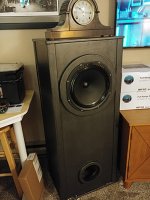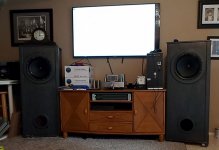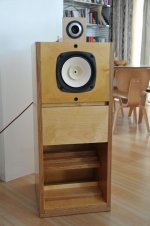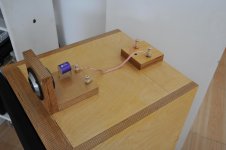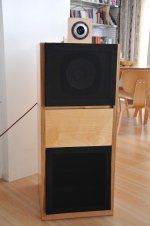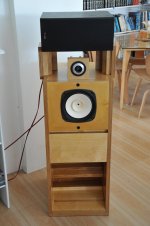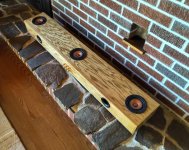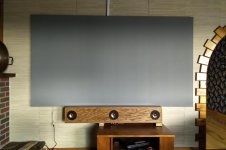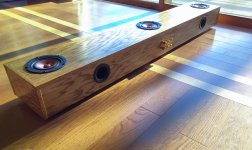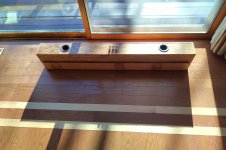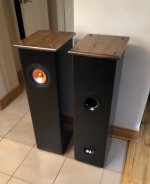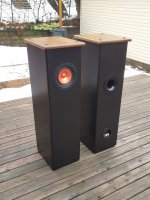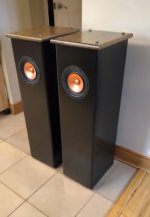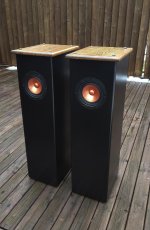I'm using the ACA version 1.2, with a linear power supply instead of the SMPS bricks, and B1 buffer.
They are my favorite speakers at the moment, placed in a closed shelve and making good use of the "corner effect".
Just a tad more bass would be welcome, listening from 1.5 meters away, but they really shine in a near field position.
Perhaps the same design with a FF105WK (the Falcon) would be just what I need.
They are my favorite speakers at the moment, placed in a closed shelve and making good use of the "corner effect".
Just a tad more bass would be welcome, listening from 1.5 meters away, but they really shine in a near field position.
Perhaps the same design with a FF105WK (the Falcon) would be just what I need.
Just a tad more bass would be welcome, listening from 1.5 meters away, but they really shine in a near field position.
Perhaps the same design with a FF105WK (the Falcon) would be just what I need.
If the speakers are very new, it is likely there will be a little "break in" and you might hear a slight change in the sound after more hours on them. No experience with FF85WK but read that these are nice sounding wide-band (aka Full-range) drivers within ~3" options.
you might hear a slight change in the sound after more hours on them
Yes, I'm counting on it.
They do sound very nice. The whole DIY speaker/full range idea, that I began reading about and toying with some 5 months ago has been very interesting and rewarding.
The pair I built (Post 4055) were a couple of months breaking in. Your mileage may vary ��. Recently rebuilt the x-overs with Mundorf Supremes, which take about a 100 hrs. I’m learning cables take time as well. It’s fascinating to see how much has changed since my last pair of speakers 20 odd years ago. I don’t think the WAW (Woofer Assisted Wideband) were possible back then. And with the advent of mini dsp (which to be honest, I don’t understand very well) you can sidestep the huge caps and coils needed with the low WAW crossover points.
Well, those horns are some serious building!The pair I built (Post 4055) were a couple of months breaking in
Perhaps the same design with a FF105WK (the Falcon) would be just what I need.
Congrats on the successful build! Give your Lances a few hundred hours to break in, and if you still want more bass, I can attest to the performance of the Falcon. I built a pair with lauan plywood and was very happy with them. Astonishingly good bass for their size.
Will do that.Give your Lances a few hundred hours to break in
I'm also trying the same concept for the Pluvia 7, but the FF85's are more pleasing to my aging years, so far.
Fostex Fe206en
Hello to everybody, I saw here some amazing project so very humbly I show my build Fostex Fe206en 8" with additional Fostex FT17H Horn Super Tweeter in open baffle.
I used a baltic birch plywood 24mm. The original Fostex back horn loaded design is with 21mm plywood so I had to adjust the size and the disposition of the partitions inside the box but the result is very good and I am very happy with it. I finish with Konig Polyurethane. Also for the additional tweeter I follow Fostex specifications, actually there is no need of a tweeter with the Fe206en but looks nice..🙂.
Then as it show in the picture I did and accessory with the same plywood for use the same space for my bookshelf speaker Polk Audio Monitor 40.
Best Regards to everybody.
Hello to everybody, I saw here some amazing project so very humbly I show my build Fostex Fe206en 8" with additional Fostex FT17H Horn Super Tweeter in open baffle.
I used a baltic birch plywood 24mm. The original Fostex back horn loaded design is with 21mm plywood so I had to adjust the size and the disposition of the partitions inside the box but the result is very good and I am very happy with it. I finish with Konig Polyurethane. Also for the additional tweeter I follow Fostex specifications, actually there is no need of a tweeter with the Fe206en but looks nice..🙂.
Then as it show in the picture I did and accessory with the same plywood for use the same space for my bookshelf speaker Polk Audio Monitor 40.
Best Regards to everybody.
Attachments
The blocks on the top for the super tweeter are quite cute.
Enjoy the music!
Thank you, you too enjoy the music 🙂
Member
Joined 2009
Paid Member
My 12 inch AV speakers.
nice build!
How do you like the sound ?
How is treble on axis and off axis ?
Soundbar I built for my in laws for Christmas. 3.0 channel, Left and Right channel are MA pluvia 7 in 7.5 liter ported chambers with downfiring ports. Center channel is sealed, approximately 3 liters. Unit will be wall mounted soon, complete with French cleat.
Box is constructed from 1/2" oak ply and solid oak frame. Stained and coated in poly urethane. All electrical connections enter the bottom of the enclosure.
Sound is quite good, due to the wall mounting there is some bass reinforcement which is pleasing with the smaller driver and enclosure. Left and right are set as full range and center is crossed over.
I had considered other MA drivers but the pluvia seemed like a good blend of quality, bass response in small enclosure, price. It also looks good without flush mounting so I got a little lazy in that regard.
I sacrificed the center enclosure size to achieve reasonable bass performance in left and right. Decided it was more reasonable to have left and right with an acceptable amount of bass than three channels with mediocre bass, considering there was limited volume to work with.
My theory as well is that by crossing over the center channel to the stereo pair it will improve coherence and leave more dynamic room for the speaker that will see the most critical parts of the soundtrack.
Their listening habits are not strenuous so no subwoofer needed.
Box is constructed from 1/2" oak ply and solid oak frame. Stained and coated in poly urethane. All electrical connections enter the bottom of the enclosure.
Sound is quite good, due to the wall mounting there is some bass reinforcement which is pleasing with the smaller driver and enclosure. Left and right are set as full range and center is crossed over.
I had considered other MA drivers but the pluvia seemed like a good blend of quality, bass response in small enclosure, price. It also looks good without flush mounting so I got a little lazy in that regard.
I sacrificed the center enclosure size to achieve reasonable bass performance in left and right. Decided it was more reasonable to have left and right with an acceptable amount of bass than three channels with mediocre bass, considering there was limited volume to work with.
My theory as well is that by crossing over the center channel to the stereo pair it will improve coherence and leave more dynamic room for the speaker that will see the most critical parts of the soundtrack.
Their listening habits are not strenuous so no subwoofer needed.
Attachments
Last edited:
Soundbar I built for my in laws for Christmas. 3.0 channel, Left and Right channel are MA pluvia 7 in 7.5 liter ported chambers with downfiring ports. Center channel is sealed, approximately 3 liters. Unit will be wall mounted soon, complete with French cleat.
Box is constructed from 1/2" oak ply and solid oak frame. Stained and coated in poly urethane. All electrical connections enter the bottom of the enclosure.
Sound is quite good, due to the wall mounting there is some bass reinforcement which is pleasing with the smaller driver and enclosure. Left and right are set as full range and center is crossed over.
I had considered other MA drivers but the pluvia seemed like a good blend of quality, bass response in small enclosure, price. It also looks good without flush mounting so I got a little lazy in that regard.
I sacrificed the center enclosure size to achieve reasonable bass performance in left and right. Decided it was more reasonable to have left and right with an acceptable amount of bass than three channels with mediocre bass, considering there was limited volume to work with.
My theory as well is that by crossing over the center channel to the stereo pair it will improve coherence and leave more dynamic room for the speaker that will see the most critical parts of the soundtrack.
Their listening habits are not strenuous so no subwoofer needed.
Congratulation very impressive building, my I ask what brand is the big screen in the picture? all the best
Congratulation very impressive building, my I ask what brand is the big screen in the picture? all the best
Thank you. Screen is actually a DIY affair as well. It's a screen for an Epson projector, basically a sheet of MDF with a custom Grey paint job mounted on the wall.
My DIY speakers are not full range, but they do use full range drivers (AER MD3 drivers in Oris 150 horns) for most of the musical spectrum (180 Hz to 8kHz) so I hope I am not bending the rules too much to post here. The bass is provided by Bill Fitzmaurice designed DIY HT Tuba corner horns. As mentioned the AER-Oris horn combo play most of the musical spectrum, and the bullet super tweeters are Fostex t900a. One unusual fact about the cabinets is that except for threaded fasteners almost all the bronze and brass parts came from a big scrap metal yard in Summerville, GA, near my home.
I have been building DIY speakers of my own design for over forty years. I have had a good run, but my biggest problem has always getting crossovers good enough to feel I was getting the best out of the drivers and cabinets I used. I avoided this problem with my most recent effort by using a DEQX DSP for crossovers, speaker correction, time and phase correction, etc. and triamplifying the three way horn speakers (see photo). I know this is an expensive path to take, but for amateur speaker builders who follow it it opens up a multitude of benefits.
An example of this is that I wanted the folded corner horns to be back in the corners of the room while I wanted the wide range and super tweeter to be out in the room where they would image best. Counting the length of the horn folded inside the bass cabinets plus the distance between those cabinet's woofers and the wide range horn's driver the acoustic centers of of those drivers were over sixteen feet apart. That obviously wouldn't work. Using DSP to digitally correct the time between drivers I could make them sound as though the acoustic centers of the two drivers were only 3 mm(less than 1/8 inch) apart.
Another great benefit is that different crossover points and roll off slopes could be tried as simply as reprogramming the DEQX. I ended up with crossovers at a nominal 200Hz and 8kHZ and all roll off slopes set to 100dB per octave. The speakers are tri-amplified with a Pass Labs X150 powering the bass and a pair of First Watt F-3s powering the wide range and super tweeters.
Admittedly this method is not for everyone, but for those who try it the benefits are many. The speakers are rather big. The corner horns are 18 cubic ft. If anyone is wondering about WAF my wife of 48 years not only accepted; she spent many hours helping me apply blonde Burmese teak veneer to the cabinets.
I have been building DIY speakers of my own design for over forty years. I have had a good run, but my biggest problem has always getting crossovers good enough to feel I was getting the best out of the drivers and cabinets I used. I avoided this problem with my most recent effort by using a DEQX DSP for crossovers, speaker correction, time and phase correction, etc. and triamplifying the three way horn speakers (see photo). I know this is an expensive path to take, but for amateur speaker builders who follow it it opens up a multitude of benefits.
An example of this is that I wanted the folded corner horns to be back in the corners of the room while I wanted the wide range and super tweeter to be out in the room where they would image best. Counting the length of the horn folded inside the bass cabinets plus the distance between those cabinet's woofers and the wide range horn's driver the acoustic centers of of those drivers were over sixteen feet apart. That obviously wouldn't work. Using DSP to digitally correct the time between drivers I could make them sound as though the acoustic centers of the two drivers were only 3 mm(less than 1/8 inch) apart.
Another great benefit is that different crossover points and roll off slopes could be tried as simply as reprogramming the DEQX. I ended up with crossovers at a nominal 200Hz and 8kHZ and all roll off slopes set to 100dB per octave. The speakers are tri-amplified with a Pass Labs X150 powering the bass and a pair of First Watt F-3s powering the wide range and super tweeters.
Admittedly this method is not for everyone, but for those who try it the benefits are many. The speakers are rather big. The corner horns are 18 cubic ft. If anyone is wondering about WAF my wife of 48 years not only accepted; she spent many hours helping me apply blonde Burmese teak veneer to the cabinets.
An externally hosted image should be here but it was not working when we last tested it.
Last edited:
Those have quite the steampunk look about them. I love the use of the decorative heater vent in the base!
My DIY speakers are not full range, but they do use full range drivers (AER MD3 drivers in Oris 150 horns)
Wow, that's impressive!
- Home
- Loudspeakers
- Full Range
- Full Range Speaker Photo Gallery
